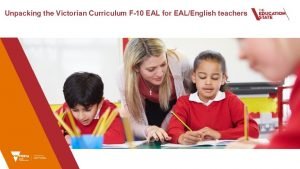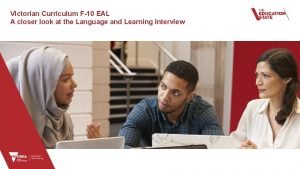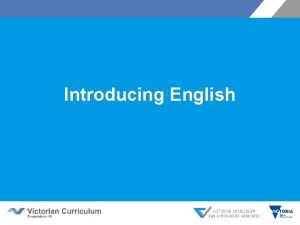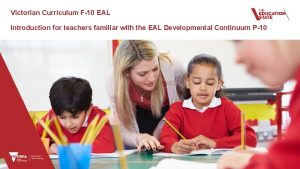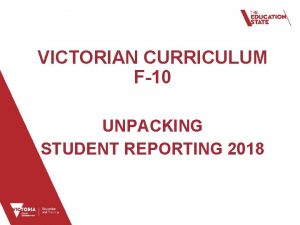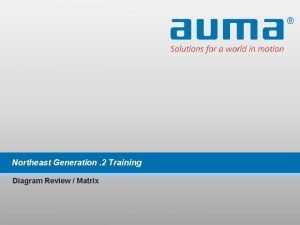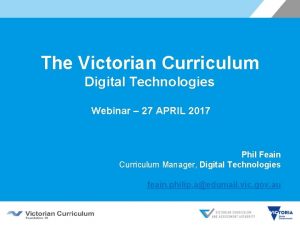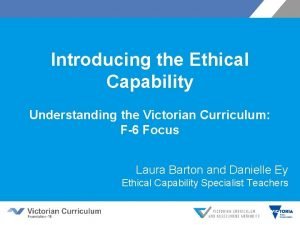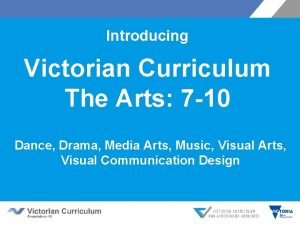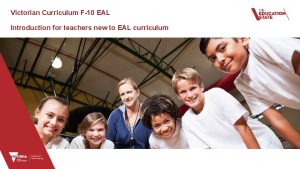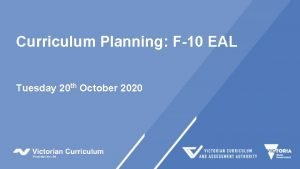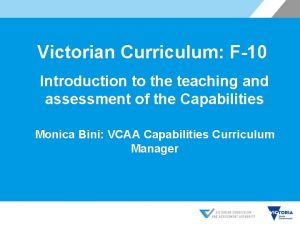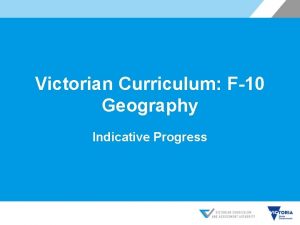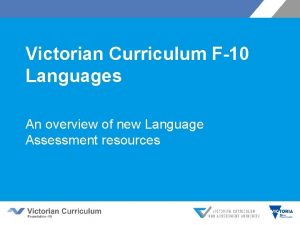Unpacking the Victorian Curriculum F10 EAL for EALEnglish











- Slides: 11

Unpacking the Victorian Curriculum F-10 EAL for EAL/English teachers 1

Unpacking the Victorian Curriculum F-10 EAL for EAL/English teachers At the end of this session, you will: • understand the EAL pathways and levels in the EAL curriculum • understand how the EAL curriculum pathways and levels can be used to inform your own teaching. 2

What do the levels in Pathway A mean? EAL Pathway A: early immersion (Foundation to Year 2) EAL learners at Pathway A: • are in the early years of their lives and are still exploring the world through concrete experiences • typically develop their language and literacy skills through experiences in the school context • may have some experience of informal prior learning or preschool in Australia or overseas • may have some experience of formal learning in their home language or other languages • are able to interact and communicate using known languages and non-verbal language. Two levels of language learning in EAL Pathway A: • A 1 – little or no experience of literacy in English • A 2 – emerging/consolidating levels of English proficiency Generally students who enter Foundation are pre-literate, regardless of their language background, and hence there is no Level AL. EAL students who enter Foundation with minimal literacy in other languages will begin their early immersion in English at Level A 1. 3

What do the levels in Pathway B mean? EAL Pathway B: mid immersion (Years 2 to 8) EAL learners at Pathway B: • have approximately seven to 13 years of life experiences, and have developed some understanding of the world • may have some experience of informal learning in their home language or other languages • may not have experienced formal schooling in any language • may have experienced formal learning (in home language or other languages) that is equivalent to their English-speaking peers • have experience of the social use of at least one language, which they can use as they learn English at school. Four levels of language learning: • BL – no or limited prior formal learning and no or limited levels of literacy in English and first language • B 1 – with prior experience of formal learning, beginner levels of English proficiency • B 2 – with prior experience of formal learning, emerging levels of English proficiency • B 3 – with prior experience of formal learning, consolidating levels of English proficiency EAL learners without prior formal learning and with minimal home language literacy experience will begin this pathway at Level BL. Depending on their proficiency in English, learners with prior experience of formal learning may begin Pathway B at any other level. Note: The overlap between the pathways (Years 2 to 8) offers schools some flexibility in determining the most appropriate developmental pathway for each EAL student. 4

What do the levels in Pathway C mean? EAL Pathway C: late immersion (Years 7 to 10) EAL learners at Pathway C: • have more than 12 years of life experiences, and have developed a good understanding of the world • may have some experience of informal learning in their home language or other languages • may not have experienced formal schooling in any language • may have experienced formal learning (in home language or other languages) that is equivalent to their English-speaking peers • have an understanding of themselves and their relations with others in different social contexts • are capable of understanding abstract ideas and relationships in their experience and learning about the world • have experience of the social use of at least one language, which they can use as they learn English at school. Five levels of language learning: CL – no or limited prior formal learning and no or limited levels of literacy in English and first language C 1 – with prior experience of formal learning, beginning levels of English proficiency C 2 – with prior experience of formal learning, beginning/emerging levels of English proficiency C 3 – with prior experience of formal learning, emerging/consolidating levels of English proficiency C 4 – with prior experience of formal learning, consolidating levels of English proficiency EAL learners without prior formal learning and with minimal home language literacy experience will begin this pathway at Level CL. Depending on their proficiency in English, learners with prior experience of formal learning may begin Pathway C at any other level. 5

Unpacking the EAL curriculum Activity 1: Using the EAL curriculum LEVEL 3 WRITING PLANNER Purpose: For EAL students to research, plan, draft and publish an information report. English Level 3 Content Descriptions (Writing) English Level 4 Content Descriptions (Writing) Plan, draft and publish imaginative, informative and persuasive texts demonstrating increasing control over text structures and language features and selecting print and multimodal elements appropriate to the audience and purpose (VCELY 266) Plan, draft and publish imaginative, informative and persuasive texts containing key information and supporting details for a widening range of audiences, demonstrating increasing control over text structures and language features (VCELY 299) Understand that a clause is a unit of grammar usually containing a subject and a verb and that these need to be in agreement (VCELA 261) Understand that the meaning of sentences can be enriched through the use of noun groups/phrases and verb groups/phrases and prepositional phrases (VCELA 292) Adapted from VCAA examples of whole-school curriculum plans EAL B 1 Content Descriptions (Speaking and listening) EAL B 1 Content Descriptions (Reading and viewing) EAL B 1 Content Descriptions (Writing) Understand a range of simple texts based on predictable language structures and vocabulary (VCEALC 264) Create short, simple texts for particular purposes, with some support and modelling (VCEALA 300) Sample Use a small range of basic verb forms accurately (VCEALL 255) Use learnt words in speech (VCEALL 260) Read sentences that use basic subject, verb and object patterns, where content and vocabulary are familiar (VCEALL 283) Use simple sentences and phrases with correct subject– verb–object pattern (VCEALL 310) Use common verb forms correctly (VCEALL 311) Multiple exposures to targeted language across all three modes 6

Unpacking the EAL curriculum activity 1: Using the EAL curriculum Review a planning document from your school in relation to the EAL curriculum, for example a term reading planner, an inquiry unit of work or an individual learning plan. Look at the appropriate EAL pathway and level for your EAL student(s). An EAL student’s level might not be the same across the three language modes. For example, he/she might be at Level B 2 for Reading and viewing, but at Level B 1 for both Speaking and listening and Writing. Identify relevant EAL content descriptions from each of the language modes and strands that relate to your plans for teaching and learning. 7

Unpacking the EAL curriculum activity 2: Differentiated teaching for EAL students WRITING LESSON PLAN Purpose: To understand the text structures and linguistic features of an information report. English EAL differentiated teaching 1. Provide students with a range of information reports. Do not reveal genre. Provide EAL students with two information reports with similar structures and written in accessible language, with organisational features such as sub headings for each paragraph. 2. Students work in groups to look at language features (highlight and annotate). What are the similarities and differences? What are the features? Try to determine the genre. Provide EAL students with a checklist of language features to identify. For example, does this text use: • proper nouns or common nouns • present tense verbs or past tense verbs? Use the checklist and refer to posters of text types to determine the genre. 3. Share findings and reveal genre. Create class poster on features of information reports. EAL students contribute to discussion using their checklist. Sa e l p m Adapted from VCAA examples of whole-school curriculum plans 8

Unpacking the EAL curriculum activity 2: Differentiated teaching for EAL students Review a lesson plan from your school. Consider how you would make each stage of the lesson more explicit for your EAL students. 9

Suggestions for next steps Explore the Literacy Teaching Toolkits. Both the Foundation to Level 6 and Level 7 to 10 toolkits provide different ideas and strategies that may be applicable to learning areas across primary and secondary. Discuss how all teachers could work together in your school to support EAL learners across the entire Victorian curriculum. 10

© State of Victoria (Department of Education and Training) 2020 Unpacking the Victorian Curriculum F-10 EAL content descriptions and elaborations is provided under a Creative Commons Attribution 4. 0 International licence. You are free to re-use the work under that licence, on the condition that you credit the State of Victoria (Department of Education and Training), indicate if changes were made and comply with the other licence terms, see: Creative Commons Attribution 4. 0 International The licence does not apply to: • any images, photographs, trademarks or branding, including the Victorian Government logo and the DET logo; and • content supplied by third parties. Copyright queries may be directed to copyright@edumail. vic. gov. au 11
 Victorian curriculum eal
Victorian curriculum eal Eal victorian curriculum
Eal victorian curriculum English curriculum victoria
English curriculum victoria Eal curriculum scope and sequence
Eal curriculum scope and sequence Vcesl
Vcesl Auma ac01.2 wiring diagram
Auma ac01.2 wiring diagram F10
F10 Victorian era floral arrangements
Victorian era floral arrangements Which era is known for symmetrical tree like designs
Which era is known for symmetrical tree like designs Victorian curriculum progression points
Victorian curriculum progression points Victorian curriculum ethical capabilities
Victorian curriculum ethical capabilities Dance curriculum victoria
Dance curriculum victoria
